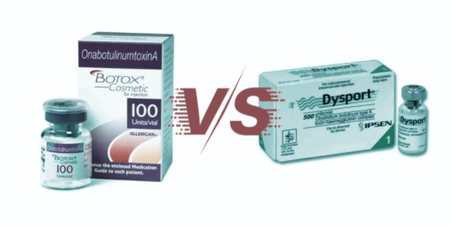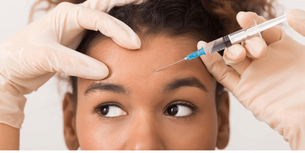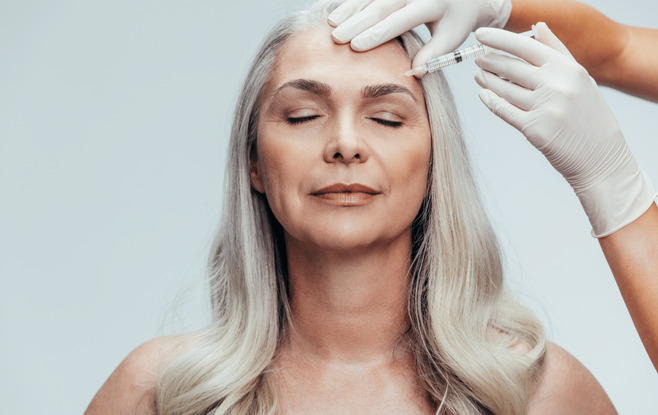Botox vs Dysport: what’s the difference

Wrinkles are a natural sign of aging. Over time, our skin loses its elasticity thanks to reduced collagen, reduced elastin, smoking, and increased sun exposure. Facial expressions such as frowning, squinting, and even smiling can make wrinkles seem more pronounced. Sometimes, these wrinkles show up sooner than we expect. As the saying goes, Old age puts more wrinkles in our minds than our faces. We want to look as young as we feel! With injectables like Botox and Dysport, we can now do that and so much more. Here, we’ll talk about injectables and break down the Botox vs Dysport debate.
Furthermore, if you’re considering looking for a solution to reduce the signs of wrinkles, our team at Eternal Dermatology can help. We have extensive expertise with injectables like Botox, Dysport, and several others.
All about injectables
Sometimes, taking care of our skin, drinking water, and using cosmetic products are not enough to bring wrinkle-free revitalized skin. Injectables are an excellent, non-surgical way to smooth out our pesky wrinkles. Some can even bring more volume to part of our face. Simply put, injectables are chemical substances ‘injected’ in strategic areas of our face. These injectables can reduce the signs of wrinkles and even help contour parts of the body. Injectables were once considered taboo, but now, we’ve seen almost 2.5 million injectable procedures performed every year since 2015.
Injectables are split into two categories: neuromodulators, and soft-tissue fillers. Neuromodulators focus on reducing lines caused by facial movement. Soft-tissue fillers look to increase volume lost with age in areas like the cheeks, lips, chin, and forehead. Botox and Dysport fall under neuromodulators can each has advantages in keeping wrinkles at bay for months at a time.
What is Botox?
Botox is a neuromodulator produced from the bacterium clostridium botulinum. Botox is also known as Botulinum Type A and, when used in controlled amounts, can reduce or remove fine lines and wrinkles. The injectable works by blocking the nerve signals in the muscles in the face to the brain. When used incorrectly, the toxin can be quite dangerous and can present unwanted botulism symptoms. But in the right hands, such as a board-certified dermatologist or plastic surgeon, Botox is safe and effective.
When Botox blocks the nerve signals in the face, the muscles cannot contract as freely as before. This lack of movement smooths out the skin and significantly reduces the appearance of wrinkles. Botox was the first FDA-approved Botulinum Type A neuromodulator, coming onto the market in 1989, before approval for cosmetic use in 2002. It’s since become the flagship brand in the injectables space. Furthermore, Botox can be used for a range of medical conditions as well. Check out our blog on the 11 Uses of Botox for some other interesting ways it can help you.
What is Dysport?

Since the inception of Botox, other companies have brought injectables on the market to help with wrinkles. Soon after Botox was launched, Dysport was considered its European counterpart, serving over 60 countries worldwide. In 2009, the FDA approved Dysport for use in the United States. Since then, it’s been proven to be an effective, non-invasive treatment for wrinkles, and fine lines. Both Botox and Dysport had medical uses before approval for cosmetic use.
Like Botox, Botulinum Type A is Dysport’s active ingredient. Once injected, Dysport disables the nerves around the injection site. This limits muscle movement, relaxing the area and smoothing out the skin. However, Dysport positions itself primarily to treat moderate to severe forehead lines and glabellar lines sometimes called frown lines or 11 lines. Your board-certified dermatologist should have access to both products and can even use them both in different parts of your face.
Botox vs Dysport: What’s the difference?
At first glance, there seems to be no real difference between Botox and Dysport. Both contain the same active ingredient (Botulinum Type A) and can reduce the appearance of wrinkles. However, there are some key distinctions that will make your dermatologist choose one over the other.
The biggest difference is the level of concentration in each product. Dysport is more diluted than Botox, with an almost 3 to 1 split. Based on the location of the injectable, your doctor may need more product to fill one area than another. Of course, it’s easy to believe then that Dysport will be much more expensive than Botox, but this is not the case. The price per unit is significantly cheaper than Botox. Since the number of units will be higher than Botox, the price per treatment comes up to about the same.
Dysport also differs in terms of its molecular behavior and diffusion. This makeup means it spreads faster, especially over a larger surface area, with just a few injections. So the differences really come down to the way each injectable is applied by your doctor. An experienced doctor will use both for certain areas:
- Botox will work well for lip lines, Crow’s feet, and other fine wrinkles. It has a high concentration and is slow-moving, making it perfect for these small areas.
- Dysport will work well for larger surface areas like the forehead and 11 lines. It’s fast-acting, spreading quickly and evenly.
Because of the difference in dilution, you can safely use both for a similar price.
Who is a good candidate for Botox vs Dysport?

Both Botox and Dysport are FDA approved. Most doctors suggest that adults between 35 and 65 are the best candidates. Other factors include:
- You should have mild to severe facial wrinkles that have not responded well to dermatologist-recommended skin care techniques.
- Your wrinkles should be in positions that both Dysport or Botox can help like around the lips, cheeks, eyes, chin, and forehead.
- You should be in relatively good health without any preexisting skin conditions.
If you’re pregnant, breastfeeding, have skin allergies, or a known Botulinum Type A allergy, you should avoid the procedure. Let your doctor know about any severe illnesses, conditions, or potentially dangerous infections.
Are there any differences with the procedures?
The process for both Dysport and Botox are exactly the same. Your injectable journey starts off with an initial consultation with your dermatologist. The dermatologist checks your current medical history, assesses the current wrinkles on the face, and comes up with a game plan. Sometimes, that game plan contains both Dysport and Botox in the same session.
Botox and Dysport are non-invasive procedures that take less than 30 minutes in some cases. It’s not uncommon for patients to have their injectable on their lunch break. Compared to invasive procedures, injectables have shorter recovery and high success rate. The biggest difference during the procedure would be the injectable used at the time.
Your doctor will mark off the intended injection sites, then use a topical agent to numb the skin. Your doctor will then inject the Botox or Dysport in the appropriate spots. Dysport injections may at times be deeper than Botox injections. The deeper shot helps to cover the wider treatment areas. After checking your skin to make sure all goes well, you can leave and go about your day. Your doctor will give you some simple do’s and don’ts such as:
- Avoiding alcohol for at least 48 hours.
- Do not massage your face or injection areas to avoid spreading the neuromodulator to other parts of the face.
- Avoiding exercise or strenuous activity for at least 4 hours.
- Avoiding direct sun exposure for at least 24 hours.
- Do not lay down for 3 hours after.
Over the next few days, you’ll start to see changes in your wrinkles and overall look.
Are there any differences in the effectiveness?
Both injectables have excellent success rates with reducing the signs of wrinkles. In a 2019 study, 88% of patients were extremely satisfied with the results after just 30 days. Dysport lasts between 3 to 4 months needing additional treatments to keep the amazing results.
Botox is a safe, effective treatment that can last for as long as 4 months, although it can possibly last for 6 months, depending on the location of the injectable. In smaller areas like the eyes and lips, Botox tends to last much longer. Over time, the neuromodulator will break down into simple proteins that will be absorbed by the body. From there, you’ll see some movement in your muscles again, (but fewer wrinkles) which is a great time to schedule your next visit.
What about the side effects?
Since both contain the Botulinum Toxin Type A, they share the same potential side effects. Remember, that any medical or cosmetic procedure will have a degree of risk. Common reactions include pain and swelling at the injection site, headache, ptosos (droopy eyelid) and dryness (if the injection is near the eyes). More serious reactions include muscle weakness, trouble swallowing, and breathing. Side effects are rare if your treatments are handled by a licensed professional.
Can you combine Botox and Dysport with other treatments?
It’s not uncommon for patients to ask about other treatments along with Botox or Dysport. For instance, you can get an injectable filler, which can plump up your skin and add much-needed volume. These fillers, like Juvederm or Restylane, contain hyaluronic acid, a natural compound found in the skin. When used alongside Botox or Dysport, a patient can get a “liquid facelift”. Liquid facelifts are becoming a widely popular option since you can avoid major surgery altogether.
Some patients may ask about other treatments like lasers, chemical peels, hydrafacials, or more. It’s understandable that these patients would want the best treatment as quickly as possible. However, each procedure happens on a case-by-case basis. Your dermatologist will err on the side of caution, making sure to complete your Botox or Dysport treatments first. Once all goes well, you can come back for another treatment to treat another problem area at another time.
Conclusion: Know the differences
In the Botox vs Dysport debate, you’ll come to find that it’s really difficult to compare the two injectables. Both Dysport and Botox are effective in reducing moderate to severe wrinkles and fine lines.
The biggest difference comes in the formulations of both injectables. Dysport is much more diluted and spreads quickly compared to Botox. This makes it great for larger surface areas like the forehead. Botox is much more potent, making it amazing for small areas and pesky wrinkles like Crow’s feet. That means the biggest difference comes down to how much injectable is used and how long it takes to work.
It also comes down to the expert using the injectable. A board-certified dermatologist with extensive knowledge on all things injectable means they will select the best one for you. At Eternal Dermatology, our board-certified dermatologist, Ife Rodney, MD FAAD, understands how Botox and Dysport affect the different lines and wrinkles on your face. From there, she can devise a plan to help you look and feel years younger.
To schedule a Botox or Dysport consultation, reach out to us today. We’re conveniently located in Fulton, MD, and serve patients in Columbia, Silver Springs, Howard County, Baltimore, and surrounding areas.
There are a few ways you can connect with us:
- Book an appointment directly on our website.
- You can also request a consultation by clicking the link at the bottom of our homepage.
- Call or email us via our Contact Page.
Get the right neuromodulator for your pesky wrinkles and enjoy a fresh, youthful look, with our help.
